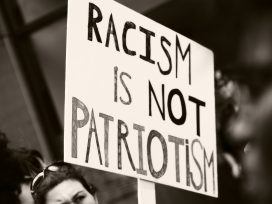‘Black people are the magical faces at the bottom of society’s well. Even the poorest whites, those who must live their lives only a few levels above, gain their self-esteem by gazing down on us. Surely, they must know that their deliverance depends on letting down their ropes. Only by working together is escape possible. Over time, many reach out, but most simply watch, mesmerized into maintaining their unspoken commitment to keeping us where we are, at whatever cost to them, as to us.’
That is the arresting image that opens Derrick Bell’s 1992 book Faces at the Bottom of the Well. It is a work of existential despair, but, for Bell, the only realistic way of thinking about the place in which African Americans find themselves. Racism, he wrote, ‘is an integral, permanent and indestructible component of this society’. Black people ‘will never gain full equality’. Even ‘those herculean efforts we hail as successful will produce no more than temporary “peaks of progress”, short-lived victories that slide into irrelevance as racial patterns adapt in ways that maintain white dominance. This is a hard-to-accept fact that all history verifies.’ Not to accept that fact was to do great mental and emotional harm. Since ‘racial equality is… not a realistic goal’, to be ‘constantly aiming for a status that is unobtainable in a perilously racist America’ would lead only to ‘frustration and despair’.
Derrick Bell is not a household name. Yet few people have been more important in shaping contemporary thinking about race, particularly in the United States. From Barack Obama to Ta-Nehisi Coates, leading black thinkers have paid tribute to Bell’s inspiration. There are not many legal scholars in recent memory, wrote Michelle Alexander, the influential author of The New Jim Crow, who ‘have [had] a greater impact on racial justice thought and advocacy’.
Bell is the godfather of what is now called Critical Race Theory (CRT). Beginning as a movement within American legal studies that brought a postmodern sensibility to thinking about the law, CRT developed into a critique of the liberal ‘civil rights’ approach to tackling racism, a critique nurtured by a hostility to universalism, humanism and the Enlightenment.
‘Enlightenment-style Western democracy is… the source of black people’s subordination,’ wrote Richard Delgado, one of the movement’s founders, because ‘racism and enlightenment [sic] are the same thing’. Many of the themes that CRT champions – the centrality of race, rather than of class, to discussions about social issues; the view of racism as a problem of whiteness; the significance of ‘white privilege’; the disparagement of the Enlightenment legacy; the politicisation of identity – became much more widely suffused in 21st-century debates about race and racism, moulding thinkers from Ibram X. Kendi to Robin DiAngelo.
Bell’s pessimism, and the arguments underpinning Critical Race Theory, were shaped by the specific conditions of America: the history of slavery, the depth of Jim Crow culture in the South, as well as disenchantment with the limited change in the material conditions of black people’s lives brought about by the civil rights movement. But these arguments have since become influential well beyond the US.
Across the globe, debates about race are often unreflectingly shaped by ideas and movements originating in the US, whether Black Power in the 1960s or the contemporary culture wars. That influence, underpinned by America’s economic, political and cultural weight, makes it important that we look even more carefully at those ideas and developments, unpack the myths and unpick the arguments. In understanding the American debates we understand more also about the debates beyond the US, including in our own country.

‘Othering’, by Laura Avellaneda-Cruz via Flickr.
Born in Pittsburgh in 1930, Bell attended the University of Pittsburgh’s law school, the only black graduate in his class, before becoming an attorney in the NAACP Legal Defense Fund. As part of the civil rights assault on Jim Crow, Bell supervised the desegregation of more than 300 schools. Desegregation often led to white flight, as white families moved elsewhere rather than send their children to integrated institutions. The result was that many desegregated schools remained segregated, not by formal procedure but through informal practice.
This conundrum led Bell to question whether it was truly possible to rid society of racism. He had taken his first step on the road to racial pessimism. In 1969, Bell joined Harvard Law School. At the end of the decade, he published perhaps his most celebrated paper, challenging the conventional view of Brown v Board of Education, the famous 1954 Supreme Court case that invalidated state- sanctioned segregated schools.
Well of despair
Desegregation was not the consequence of a moral desire for racial equality, Bell insisted, but a pragmatic response to political needs, a recognition that segregation hindered ‘America’s struggle with communist countries to win the hearts and minds of emerging third world people’ and was ‘a barrier to further industrialization in the South’. Racial progress only occurred when it aligned with white interests, and when those interests changed, any attachment to equality was ditched. Whites, he wrote, ‘simply cannot envision the personal responsibility and the potential sacrifice… that true equality for blacks will require.’
In reality, desegregation was the product of many developments. The American authorities were certainly worried about the image created by Jim Crow and wanted to minimise its propaganda value to the Soviet Union. Desegregation was also a response to the long struggle, not just by black Americans, against racism. The recognition of the immorality of American apartheid played its role, too. And the overthrow of Jim Crow, while it did not bring about the kind of equality African Americans hoped for, nevertheless helped reset the moral dial. The attitude of most Americans to issues from equality to interracial marriage was very different by the end of the century than it had been in the era of Jim Crow.
In Bell’s view, however, because racism was ineradicable, not only would antiracist action ‘not lead to transcendent change’ but it ‘may indeed, despite our best efforts, be of more help to the system we despise than to the victims of that system whom we are trying to help.’ And yet, he insisted, antiracists must continue struggling against racism even as they acknowledged that there could be no prospect of success. They had to combine ‘recognition of the futility of action’ with ‘the unalterable conviction that something must be done, that action must be taken’.
Few who were inspired by Bell’s work tumbled as far as he did into the well of despair, but pessimism has nevertheless shaped much contemporary thinking about race. ‘Isn’t it time we ask ourselves: What if Bell was right?’. Michelle Alexander reflected in a foreword to a new edition of Faces at the Bottom of the Well in 2018. ‘What if justice for the dark faces at “the bottom of the well” can’t actually be won in the United States? … What if racism is permanent? What if?’
It is a pessimism rooted in many trends: the left’s disenchantment with the Enlightenment and with the working class, the degradation of the universalist tradition, the institutionalisation of neoliberalism, the enervation of the labour movement. Like Bell himself, Alexander insists that ‘accepting the permanence of racism in this country does not mean accepting racism’.
Yet challenging racism while at the same time believing it to be ineradicable has inevitably shaped the character of antiracism today. It has prompted a shift from campaigns for material change to demands for symbolic gestures and representational fairness. After all, if racism is permanent, and attempts to eliminate it futile, then antiracism becomes reduced to little more than a kind of public performance or finger-wagging at white people to make them feel guilty or, at best, an attempt to make the unfairness a little less unfair. ‘These days’, as influential sociologist and cultural theorist Paul Gilroy has observed, identity too often ‘ceases to be an ongoing process of self-making and social interaction’, but ‘becomes instead a thing to be possessed and displayed.’
It also becomes a thing to be guarded and policed. For, if racism is permanent and ineradicable, then combatting it cannot be about winning equality but can only be about carving out a space within which one can assert a degree of power and autonomy. Hence the demand to ‘Stay in your lane’. Perhaps no issue expresses this better than the controversy over ‘cultural appropriation’.
Who owns the pain?
On the evening of 24 August 1955, 14-year-old African American Emmett Till went with some friends to Bryant’s Grocery in Money, Mississippi. Living in Chicago, he had come to Mississippi to visit relatives. He walked into the shop and bought two cents’ worth of bubble gum. Witnesses claimed that Till flirted with the white shop owner, Carolyn Bryant. Four days after the alleged incident, in the dead of night, her husband Roy Bryant and his half-brother J. W. Milam, who had been out of town on a trucking job, drove to the house where Till was staying and kidnapped the boy. They beat him up and mutilated him before shooting him in the head and dumping the body in the Tallahatchie River. The following month, an all-white jury found Bryant and Milam not guilty of murder. Protected against double jeopardy, the two men admitted in a 1956 interview with Look magazine that they had tortured and murdered the boy. They received $4,000 for their story.
Till’s mother Mamie Elizabeth Till-Mobley insisted on an open casket at her son’s funeral to expose to the world the savagery of lynchings. She invited photographers to capture the mutilated body. ‘I wanted the world to see what they did to my baby,’ she said. Fifty thousand people saw Emmett Till’s disfigured body as it lay in its open casket in church. Millions more saw the photographs in Jet magazine, causing shock and outrage. Emmett Till, and the haunting photographs of his broken body, became an indelible, almost ineffable, symbol for the burgeoning civil rights movement.
More than half a century later, the murder of Emmett Till generated another kind of controversy – a debate over who should be allowed to depict black pain and for what reason. The 2022 biopic Till, directed by Chinonye Chukwu, faced questions about whether art should be ‘made from the trauma of American anti-Blackness’, as one British reviewer put it.
Five years earlier this question had been posed even more sharply when the artist Dana Schutz painted ‘Open Casket’, an image of Till in his coffin, drawn from the photographs. The painting was included in the 2017 Whitney Biennial Exhibition in New York. Many objected to a white painter depicting such a traumatic moment in black history. The British artist Hannah Black organized a petition to have the work destroyed. ‘Although Schutz’s intention may be to present white shame,’ her open letter read, ‘this shame is not correctly represented as a painting of a dead Black boy by a white artist.’ According to Black, ‘the subject matter is not Schutz’s; white free speech and white creative freedom have been founded on the constraint of others, and are not natural rights.’
A few months later, the novelist Zadie Smith stood in front of the painting with her children. Schutz’s work did not impress her – ‘I didn’t feel very much’ – but she pondered whether she, a biracial British woman, was deemed black enough for the subject matter to be hers? And what of her children? Their father is white: ‘by the old racial classifications of America, they are “quadroons”‘. ‘Are my children too white to engage with black suffering?’, Smith wondered. ‘How black is black enough?’ And what about Hannah Black herself? She, like Smith, is a British biracial woman. Is she ‘black enough to write this letter’, demanding the painting be destroyed, Smith mused. ‘Who owns black pain?’ Smith was attempting both to untangle the absurdities of racial categories and to push back the inclination to evaluate moral rights by virtue of the group to which individuals are deemed to belong – a practice inextricably bound with racial thinking, and its horrors.
The gatekeepers
Cultural appropriation has been defined as the ‘unauthorized use of another culture’s dance, dress, music, language, folklore, cuisine, traditional medicine, religious symbols, etc’ and as ‘an expression of privilege’ which exposes that while ‘people of color are forced to adopt elements of mainstream white culture, white people can sample at the buffet of other cultures at their leisure, picking and choosing what they wish to consume.’ The first quote is from law professor Susan Scafidi, the second from sociologist Nicki Lisa Cole, both based in the US, but these are common definitions in and outside of America. In such discussions, every culture is viewed as a fixed, self-contained unit, every culture separated from every other by a sharp discontinuity, every culture possessing a specific set of traits and forms. But what does it mean for music or a cuisine – or ‘pain’ – to ‘belong’ to a culture? And who gives permission for someone from another culture to use such cultural forms?
There are few answers to such questions because the debate about cultural appropriation is less about ownership than about gatekeeping – about the tacit rules that define social boundaries, and the legitimacy of carrying cultural baggage across those boundaries. Every society has its gatekeepers, whose role it is to protect certain institutions, maintain the privileges of particular groups and cordon off some beliefs from challenge. Gatekeepers shield not the marginalised but the powerful. Racism itself is a form of gatekeeping, a means of denying racialised groups equal rights, access and opportunities. The policing of cultural appropriation is no different, though the polarities have been reversed, and it is executed in the name of antiracism.
Many critics of cultural appropriation insist that they are opposed not to cultural engagement, but to racism. They want to protect marginalised cultures and to ensure that such cultures speak for themselves and are not simply seen through the eyes of more privileged groups. They want also to ensure that it is not white people but minorities that profit from the promotion of their culture.
It is true that cultural engagement does not take place on a level playing field but is shaped by racism and inequality. Racism ensured, for instance, that the great black pioneers of rock ’n’ roll rarely received their due, whereas many white artists, from Elvis Presley onwards, were feted as cultural icons. Yet, as poet, writer and activist Amiri Baraka has observed, the issue here is not that of cultural appropriation at all. ‘If the Beatles tell me that they learned everything they know from Blind Willie [Johnson]’, he told the cultural critic Leonard Schwartz in a radio discussion, ‘I want to know why Blind Willie is still running an elevator in Jackson, Mississippi. It’s that kind of inequality that is abusive, not the actual appropriation of culture because that’s normal.’
Transformation or recognition
Baraka is highlighting the distinction between campaigns that seek to transform the material conditions of African Americans and campaigns for ‘recognition’ or for the policing of racial boundaries. The campaigns against cultural appropriation expose how the first has been abandoned for the second. Preventing the Beatles from drawing on the work of Blind Willie Johnson would have done little to improve black people’s lives. It would not have overthrown Jim Crow laws in the 1950s. It would not rid America of discrimination in the labour market today. Nor will preventing Dana Schutz ‘profiting’ from painting Emmett Till protect the Emmett Tills of today.
Equally troubling is that a campaign such as that against Schutz’s work contains, as the American critic Adam Shatz has observed, an ‘implicit disavowal that acts of radical sympathy, and imaginative identification, are possible across racial lines’. African-American history, Shatz insists, following in the path of Frederick Douglass and WEB Du Bois and James Baldwin, ‘is American history’ and ‘confronting it [is] a common burden’. That is precisely the perspective that has been lost through the retreat from the universalist standpoint.
As novelist Kamila Shamsie pointed out, in response to a different controversy over cultural appropriation, losing this universal standpoint is a dangerous thing. ‘”You – other – are unimaginable’ is a far more problematic attitude than “You are imaginable”.’
This is an edited excerpt from Kenan Malik’s latest book, Not So Black and White (C Hurst & Co).







